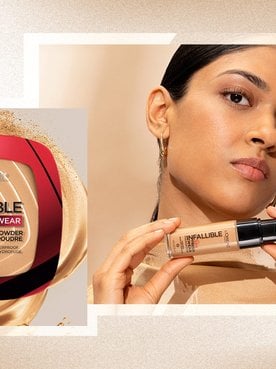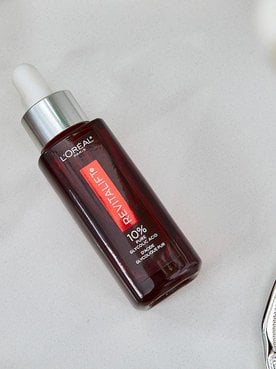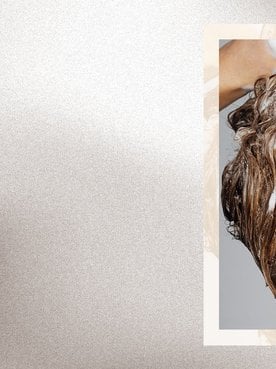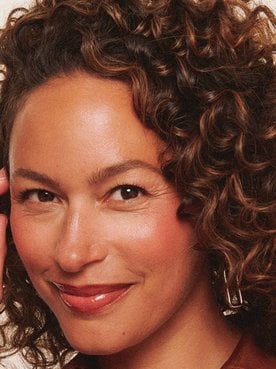When it comes to building a personalized haircare routine, understanding hair textures is a crucial first step. Your natural hair type and texture can influence everything from the products that work best for you to how often you wash your hair (and so much more). Still, identifying your texture isn’t always straightforward—many people have more than one curl pattern or find their hair behaves differently depending on the weather, environment, or even the products they use.
Whether your hair is pin-straight, coily, or somewhere in between, learning where you fall on the texture spectrum can help you better meet your haircare goals. Ahead, we’ll break down the different types of hair, explain how to identify your hair texture, and share our top tips on making the most out of your haircare routine.
What Does It Mean To Have Textured Hair?
Your hair texture refers to the overall shape of your strands, which can be straight, wavy, curly, or coily. Textured hair, meanwhile, is a broad term that refers to any hair type that isn’t naturally pin-straight. Often, it’s used to describe natural Black hair, but the term can encompass a wide range of patterns, including loose waves, springy curls, and tight coils. If your hair has any noticeable curl or wave pattern, you have textured hair.
Why Understanding Your Hair Texture Matters
Understanding your hair texture can make a major difference in how you care for your strands, from influencing how often you lather up to which products you buy.
Can help inform your routine
This probably won’t come as much of a surprise, but different hair types can have vastly different needs. Coily hair, for example, often benefits from rich, nourishing formulas that help hydrate and strengthen the hair. On the other hand, straight tresses typically do best with lightweight products that won’t weigh the hair down. Understanding your hair texture, therefore, can help ensure you’re able to give your strands what they need to look and feel their best.
Enables easier styling
Once you know how your hair naturally behaves, you can work with its pattern instead of against it. Curl definition, volume, and even heat styling all become more manageable when you tailor your techniques to your hair type and texture.
How To Identify Your Hair Texture
Hair textures are typically categorized into four main types, each with three subcategories. Your hair texture is determined by the shape your hair takes as it grows out of your scalp, not by how it looks after it’s styled. To find your natural texture, examine your hair when it’s clean, product-free, and air-dried, then compare it against the descriptions below.
Type 1: Straight hair
Type 1 hair encompasses all straight hair textures. However, not all Type 1 hair is pin-straight—in many cases, the hair has a slight bend, often towards the ends. Here’s a breakdown of each straight hair subtype:
- Type 1A: Very straight, fine, and soft with no bend or wave. This texture tends to lack volume and may be prone to oiliness, especially at the roots.
- Type 1B: Still straight, but with a bit more body and volume than 1A. Hair strands may be thicker and have a slight wave toward the ends.
- Type 1C: Straight with some coarseness and subtle texture, often appearing frizzier and less sleek than other straight hair types.
Type 2: Wavy hair
Type 2 hair can range from mostly-straight strands with a subtle S-shaped wave pattern to bouncy, beachy waves that sometimes appear curly.
- Type 2A: Loose, S-shaped waves that are fine and easy to straighten. This hair type typically lacks volume and may need help holding definition.
- Type 2B: More defined S-waves, often with a bit of frizz. This texture can hold a curl well, but may need extra care to look sleek and smooth.
- Type 2C: If you have defined waves and ringlets from root to tip, chances are, you're working with 2C hair. This texture is much coarser than other textures in the Type 2 family, with a more defined curl pattern.
Type 3: Curly hair
The Type 3 hair category encompasses a range of different types of curls, from loose, voluminous spirals to tight, bouncy ringlets.
- Type 3A: This hair texture features well-defined curls with a loose spiral or ringlet shape, typically about the circumference of a piece of sidewalk chalk.
- Type 3B: 3B curls are slightly tighter and coarser than 3A curls. This hair texture tends to be full and voluminous, but may be prone to dryness (particularly at the ends).
- Type 3C: 3C is the tightest of the three curl types. With this texture, you’ll have tight, dense, corkscrew-shaped curls typically about the circumference of a pencil.
Type 4: Coily hair
Coily hair is sometimes considered a curly hair type, but it has its own characteristics that make it distinct from Type 3 hair. This hair texture features ultra-tight S or Z-shaped coils and tends to boast a lot of volume and body.
- Type 4A: This texture features tight coils that resemble a tight S-shape. While other curl patterns may start mid-length, this coily texture begins at the scalp and continues through the ends.
- Type 4B: The defined shape of 4B hair results in a 'Z' shaped pattern that tends to bend at sharp angles instead of curling. If you have 4B hair, you may deal with dryness and tangles.
- Type 4C: 4C hair features coarse, densely packed zig-zag-shaped strands that are naturally prone to shrinkage. Oftentimes, 4C hair does not retain moisture easily and is prone to breakage when it’s not properly cared for.
Is It Possible To Have More Than One Curl Pattern Type?
Yes, it is possible to have multiple hair textures on one head. It’s especially common for those who color their hair or frequently heat style their hair, though having some natural texture variation can happen even if you have virgin hair. For instance, your crown may have 3C curls, while the nape of your neck has 4A coils. If you’re having trouble determining which category you fit best into, assess which curl pattern appears to be the most prominent, and base your routine on that hair texture.
How To Care For Your Natural Hair Texture
Once you identify your hair texture, you can begin creating a routine tailored to your unique needs and goals. If you need help getting started, we’re sharing some of our favorite products and tips for each hair texture below.
Straight hair (1A, 1B, 1C)
Straight hair tends to lack volume, which can make it look flat at times. To help give your mane body and movement, consider reaching for a volumizing shampoo and conditioner. We love the L’Oréal Paris EverPure Volume Sulfate Free Shampoo and coordinating L’Oréal Paris EverPure Volume Sulfate Free Conditioner. The shampoo gently cleanses while the conditioner provides lightweight moisture, helping to boost volume without any weigh-down.
If oily roots are your main concern, meanwhile, we suggest opting for a purifying duo to help remove debris without stripping your hair. The L’Oréal Paris Elvive Hyaluron + Pure Purifying Shampoo and L’Oréal Paris Elvive Hyaluron + Pure 72 Hour Rehydrating Conditioner fit the bill, helping to cleanse oily roots while leaving the mid-lengths and ends feeling hydrated for up to 72 hours.

Shop the Products
Wavy hair (2A, 2B, 2C)
If your hair is wavy, you’ll want to turn your focus to products that hydrate without weighing down your strands—anything too heavy can cause your waves to lose definition. For shampoo and conditioner, we love the L’Oréal Paris Elvive Hyaluron + Plump Hydrating Shampoo and L’Oréal Paris Elvive Hyaluron + Plump Hydrating Conditioner. The skincare-inspired duo is formulated with hyaluronic acid and provides intense yet lightweight moisture to help enhance shine and add bounce. The pair is suitable for all hair textures, but we find that the lightweight hydration really helps waves look their best.

For added volume and definition, you may also want to consider adding a mousse to your styling routine. The L’Oréal Paris Advanced Hairstyle BOOST IT Volume Inject Mousse gets our vote—it provides up to 24 hours of body and fullness while feeling weightless on the hair.
Shop the Products
Curly hair (3A, 3B, 3C)
Curly hair types can be prone to dryness, so if you have coils, spirals, or ringlets, it’s a good idea to seek out products that can nourish your drier strands.
Give your mane TLC starting in the shower with the L’Oréal Paris EverPure Sulfate Free Moisture Shampoo and coordinating L’Oréal Paris EverPure Sulfate Free Moisture Conditioner. Together, the gentle pair provides intense hydration, leaving the hair soft, shiny, and deeply replenished with up to four times more moisture than a non-conditioning shampoo.
Post-shower, lock in moisture with a curl-defining cream or hydrating leave-in treatment to help bring out your natural texture. We love the L’Oréal Paris Elvive Dream Lengths Curls Leave-In Conditioner, which contains hyaluronic acid and castor oil and helps to hydrate and define your natural curl pattern.

Shop the Products
Coily hair (4A, 4B, 4C)
As we mentioned earlier, coily hair tends to be dry and is often vulnerable to brittleness and breakage. Styling coils also typically requires the use of styling aids, which can contribute to build-up over time, especially since those with coily hair don’t typically need to lather up every day.
If you notice product build-up weighing down your coils, hop in the shower and lather up with a gentle clarifying shampoo, like the L’Oréal Paris EverPure Sulfate-Free Clarifying Shampoo with Antioxidants. The ultra-gentle formula helps remove product residue and buildup without stripping the hair for shiny, healthy-looking strands. After washing your coils, nourish your hair with the L’Oréal Paris EverPure Sulfate-Free Restoring Conditioner with Antioxidants, which helps lock in moisture to help restore your mane to its bounciest best.
What you use to style your coils may depend on your lifestyle, specific texture type, wash schedule, and hair porosity, but generally, adding a leave-in lotion, cream, and oil to your lineup can help ensure your natural hair stays moisturized. If you need specific advice on which leave-ins to use (or how to layer them without weighing down your hair), we suggest consulting with your hairstylist.

Shop the Products
Next Up: 11 Ways To Protect Your Hair While You Sleep
Photo courtesy of L’Oréal Paris







